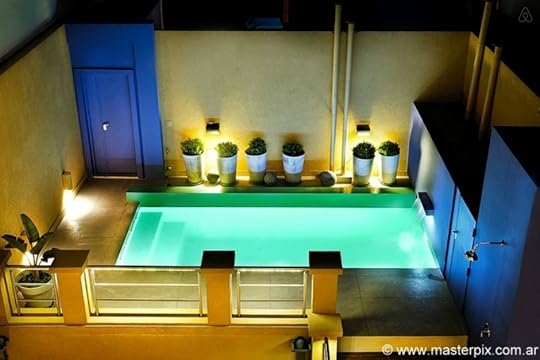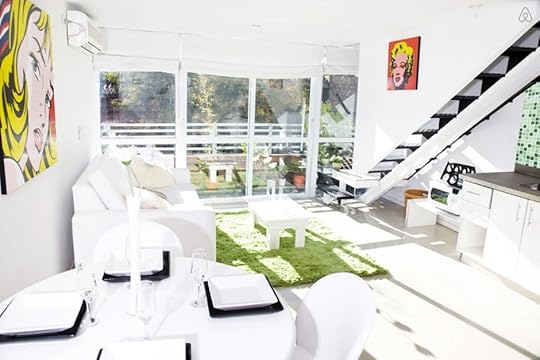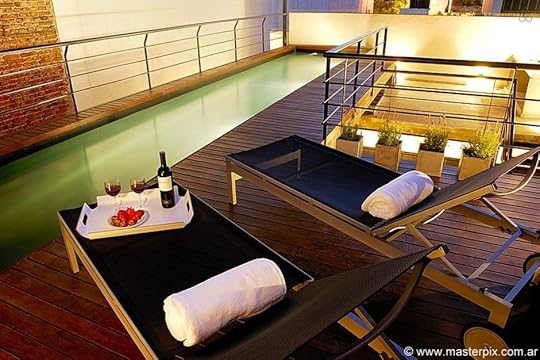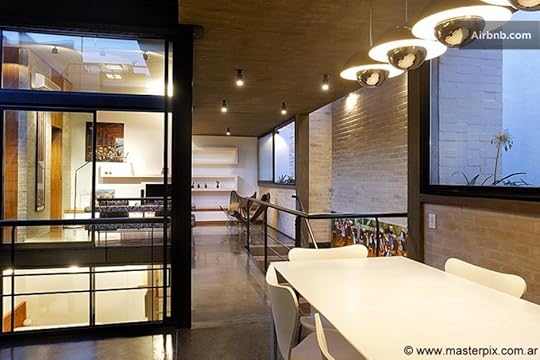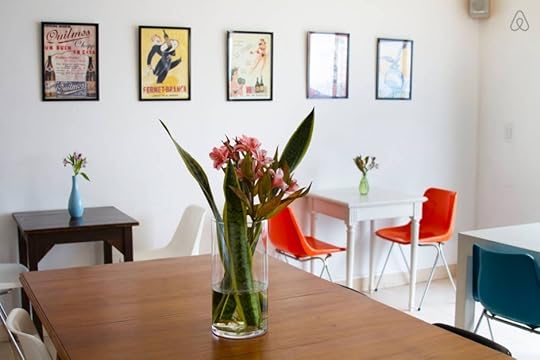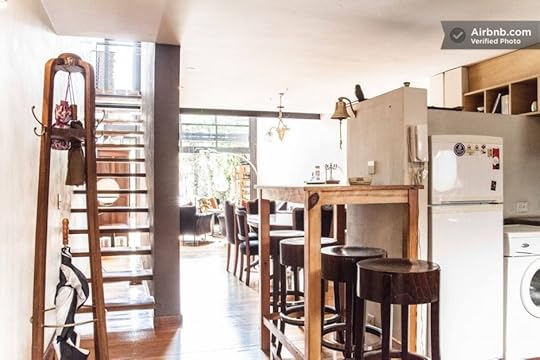Matador Network's Blog, page 2193
October 21, 2014
10 signs your boyfriend is Argentine

Photo: Christian Ostrosky
1. You kind of wish his mother was yours, but you kind of don’t.
The Argentine suegra is the sweetest of paradoxes: an all-cooking, all-laundering, all-kissing-and-hugging machine, who also sort of hates you and believes you could never be good enough for her baby. Who’s 37, by the way. And only got his own place last year. Two doors down from her place.
2. You’re tempted to check his bedroom for hidden cameras.
Why else would he be putting together such an elaborate choreography of porn moves? I mean, sure, you’re an open-minded girl, but this guy makes porn look sensitive and realistic. Also, there’s a fine line between French kissing and feeling like you’re being enthusiastically greeted by a German shepherd. Actually, it’s not even that fine.
3. He has more hair than you.
Your novio follically resembles a hybrid between Cindy Crawford and mid-80s-era Bon Jovi. He has a monobrow to put the Gallagher brothers to shame. When he takes his shirt off on the beach, small children run away, screaming.
4. You have to fight him for control of the mirror.
And the hair dryer. If he touches the crimping irons, you’re out of there.
5. He takes a deep interest in sports neither you nor he ever knew he was interested in.
We aren’t even talking about fútbol — that’s a whole different animal. Whenever a major tournament comes around, you lose all control of the remote because he feels an urgent, passionate need to support his country, whether it’s volleyball, field hockey, tennis, or any other sport you previously considered the domain of nice old tea-sipping ladies.
6. He puts your available orifice count at three, while you’d always hoped it’d be just the two.
Sometimes it seems every Argentine man you take home (and come on, you’ve taken home a few) has unorthodox snooker ideas, in that rather than potting the pink, he goes for the brown. Even when you’ve strictly no-noed any unexpected items in the bagging area, he’s still trying to get his fingers up there at every opportunity. Is something hidden up there? Is there something he knows that you don’t?
7. When socializing with his kind he turns vaguely simian.
At drunken parties, he relates to male friends by linking arms and jumping up, grunting. When seated at a pavement café with like-minded peers, the passing of women is greeted with the kind of noise used in other countries for shooing away pets.
8. He’s suspicious of foreign imports.
He dismisses much subtitled popular culture as “mierda yanqui,” regardless of its origin. He eschews exotic foods, like fish. He considers yoga gay but is even then reluctant to use such a foreign word and pronounces it “guy.”
9. He lets you call him “gordo” and “negro” and takes them as terms of endearment.
As long as he keeps calling you “flaca,” you’re not complaining.
10. When you read him this article, he takes offense.
“Baby,” he says, “but dees ees yast a leest of lazy stereotypes wreetten by a lazy gringo.” He may have a point. 

20 things you didn't know about Utah

Did you know that Utah has, on average, the tallest mountains in the country? See #12 below. Photo: josephdepalma
1. Utahns are the most generous people in the country (in the most generous country on Earth).
Out of all 50 states, people from Utah give the most of their time and money, according to a recently published Gallup poll. Of those asked during the second half of 2013, 71% had donated money and 56% had volunteered their time (48% did both). And this is in the US, the most “civically engaged” country in the world, with 65% of those asked having donated money, 43% having volunteered, and 73% having helped a stranger.
(As a Canadian who prides himself on the stereotype of being polite and kind, I’m shocked! Canadians rank quite a ways down this list.)
2. Utah has a belly button.
A town of less than 1,000, Levan sits in the geographic center of Utah. There are different theories as to the origin of its name, but the most interesting and entertaining is that Levan is “navel” spelled backwards. Besides being rich in history (it was founded in 1868 as an agricultural community) there are two nearby canyons — Chicken Creek and Pigeon Creek — that provide plenty of options for hiking, camping, fishing, and off-road excursions.
3. It’s the “Wild West” as you know it.

Photo: Kevin Galens
Near the state’s southern border is a little town of around 3,500 called Kanab. It’s sometimes referred to as “Little Hollywood” because it’s been the setting for many a television series and motion picture: big-screen flicks like The Lone Ranger, Stagecoach, Pony Express, and The Outlaw Josey Wales; and TV series including Gunsmoke, Have Gun Will Travel, and How the West Was Won. It was also the filming location of some non-western movies like Planet of the Apes (the original) and Arabian Nights. (Check out a full list of Hollywood projects shot in Kanab.)
Kanab’s Little Hollywood Museum has movie sets you can immerse yourself in, and the staff perform skits.
4. Utah gave the vote to women half a century before the rest of the country did.
It took over 70 years, from the birth of the national movement for woman suffrage in 1848 to the signing of the 19th Amendment, for American women to get the universal right to vote. But in 1870 — 50 years before the US Constitution was amended — Utah granted its female citizens this right. Sarah Young, grandniece of Brigham Young, was the first woman in the Utah territory to vote.
5. It’s home to the heaviest known organism in the world.

Photo: J Zapell
Spread over 106 acres, Pando (aka The Trembling Giant) is a male quaking aspen tree that comprises an entire forest. It’s believed that the tree is 80,000 years old, although there are other theories that place it closer to a million years old.
All of the more than 40,000 “trees” you see above are actually stems of Pando that have an average age of 130 years; they share a single root system and have identical genetic markers. As a whole, the entity is estimated to weigh around 13 million pounds. Forest fires, which Pando survives easily due to its protected root system, have kept other tree species from moving into the area, which is located in Fishlake National Forest a short drive northwest of Capitol Reef National Park.
6. There’s a successful and growing microbrew scene.
It’s a common misconception that you can’t drink alcohol in Utah — or at least that it’s hard to get your hands on a decent drink. But while Utah’s liquor laws may differ from those of other states, it’s certainly not difficult to find somewhere to enjoy a locally brewed beer.
Today, there are 21 breweries and brewpubs in the state, including several that have won national awards — Wasatch, Squatters, Moab, Uinta, Red Rock…the list goes on. As a whole, Utah is the state with the lowest beer consumption in the nation. But hey, that just means more for you and me, right?
7. It’s rich in dinosaur history.

Photo: daveynin
In the San Rafael Swell near Cleveland, Utah is the Cleveland-Lloyd Dinosaur Quarry — home to the densest concentration of Jurassic-era (around 201 million to 145 million years ago) fossils ever discovered. More than 12,000 bones — from at least 74 dinosaurs — have so far been excavated. One of the big mysteries of this ancient grave site is the presence of so many animals, and that around 75% of the bones found came from meat-eaters.
Visitors can check out the museum, walk around a large excavation area to view partially uncovered skeletons, and hike on designated trails.
8. It’s on track to end homelessness by 2015.
Almost 10 years ago, Utah set in motion policies with the goal of ending long-term homelessness by 2015. Since then they’ve managed to reduce it by 74% by, essentially, giving homes to people without homes. Sounds ludicrous, right? It was a decision based on sound logic — the policymakers realized it’s cheaper to provide a home and a social worker to someone than to pay for their emergency room visits and jail stays.
9. It’s home to some of the best powder on Earth.
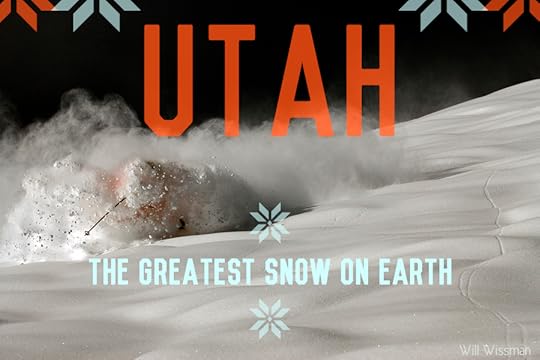
Because of their inland location, the snow that falls on Utah’s 15 ski resorts is unusually dry. Add to that the fact that the Great Salt Lake never freezes, resulting in the “Salt Lake Effect” — storms passing over the lake pick up moisture and drop it over the mountains as dry powder.
The top four ski areas for snowfall are all within a 45-minute drive of Salt Lake City: Alta gets an average of 560 inches, while the other three — Snowbird, Solitude, and Brighton — each receive around 500 inches per year. “The Greatest Snow On Earth” isn’t just a marketing slogan for the state; they mean every word.
Pro tip: On average, April sees 6.7 feet of snowfall, making for phenomenal spring skiing.
10. Provo, Utah has the highest level of well-being in the US.
Of 189 cities and metropolitan areas, the Provo-Orem area tops the list for the second time in six years. Healthways (partnered with Gallup) has been publishing a well-being index for half a dozen years running. The findings are based on over 500,000 interviews in which questions about “emotional and physical health, job satisfaction, community safety, and access to food, shelter, and health care” are asked.
Of course, it doesn’t hurt that only 7% interviewed in Provo were smokers (the lowest rate in the nation), or that the city is ideally positioned as a gateway to world-renowned outdoor adventures like ice climbing and blue-ribbon fly fishing up the adjacent Provo Canyon. That’s a lot to be happy about.
11. One of the most scenic highways in America runs through its backyard.

Photo: Wolfgang Staudt
In 2002, State Route 12 was designated an “All-American Road.” Spanning 122 miles, and connecting Capitol Reef National Park and Bryce Canyon National Park, it took almost 40 years (from the ’40s to the ’80s) to complete construction. The scenic byway crosses some of the most magnificent scenery on the Colorado Plateau: red-rock desert, mesas, buttes, cliffs, and even lush mountain forests.
One of the highlights of the drive is the Hogsback, a four-mile stretch between the towns of Boulder and Escalante that curves along a narrow spine with sharp dropoffs on either side. You definitely want to drive attentively through this section!
12. On average, Utah has the tallest mountain peaks in the country.
“Utah is the rooftop of the United States,” writes Paula Huff in Hiking Utah’s Summits. Averaging the tallest peaks in each Utah county works out to 11,222 feet. The highest elevation in the state is King’s Peak, located in the Uinta Mountains in northeast Utah, at 13,528 feet.
13. One-third of Utah was underwater until relatively recently.
Around 15,000 years ago, Lake Bonneville, of which the Great Salt Lake is a remnant, was as big as Lake Michigan and covered a third of present-day Utah. The giant lake shrunk to levels below its outlet and eventually dried up, leaving salt deposits now known as the Bonneville Salt Flats. This 30,000-acre alien landscape is under the control of the Bureau of Land Management and is used for recreation and commercial interests (Independence Day and Pirates of the Caribbean: At World’s End are a couple movies that were partially filmed here). The salt flats — most easily accessed via the town of Wendover — are open to the public for visiting, but keep in mind that in 1985 it was designated an Area of Critical Environmental Concern. Follow the rules when visiting this unique and precious place.
For the anglers out there: Utah’s native trout, the Bonneville cutthroat subspecies, is making a comeback in local streams, reservoirs, and other freshwater remnants of the ancient lake with help from the Department of Wildlife Resources.
14. A motorcycle reached speeds of over 375mph here.

Photo: Dan Kunz
The Bonneville Salt Flats are also home to the Bonneville Speedway, a site where numerous land-speed records have been set. One of those is the fastest motorcycle, which averaged 605.697 km/h (376.363 mi/h) over one kilometer. While this average was measured over two runs, Rocky Robinson — the driver of the streamlined motorcycle — hit a top speed of 634 km/h (394 mi/h). The net horsepower of his machine is between 700 and 900.
There are several annual speed events at Bonneville, including Speed Week (mid-August) and World of Speed (mid-September).
15. It was the final link in the world’s first transcontinental railroad.
On May 10, 1869, the Central Pacific and Union Pacific Railroads were joined at Promontory Summit, an hour northwest of Salt Lake City, completing a transportation system that helped reduce transcontinental travel times from six months or more to one week. In 1942, the rails at Promontory Summit were salvaged for the war effort (by this time, a shorter route had been built that bypassed it to the south).
The location where the “Last Spike” was driven to connect the two railroads is protected as the Golden Spike National Historic Site.
16. Its most famous lake is way saltier than the ocean.

Photo: Wade Lehmann
The Great Salt Lake — which lies just west of Salt Lake City — is saltier than the sea. Its salinity fluctuates between 5% and 27%, compared to an average of 3.5% for the world’s oceans. Covering an average area of 1,700 square miles, it’s the largest salt lake in the Western Hemisphere.
The reason it’s so salty is because it has no outlet; salt minerals are deposited by tributary rivers, and when the water evaporates it leaves the salt behind. Fish can’t survive in this environment, although the lake is home to other wildlife like brine shrimp and various waterfowl.
There’s lots of recreation to be had on and around the Great Salt Lake: boating, sunbathing on white-sand beaches, swimming in turquoise waters, and hiking and biking on craggy Antelope Island (shown above).
17. It’s home to the nation’s first department store.
While this fact may be up for debate, the Zions Cooperative Mercantile Institution — founded in 1868 by Brigham Young — used the slogan “America’s First Department Store” for many years. Young’s idea to pool together smaller independent Mormon businesses was a reaction to discriminatory practices by non-Mormon suppliers, who raised prices for their LDS customers. By banding together, the Mormon merchants were able to place larger orders with the wholesalers, who quickly saw that it made financial sense to keep their business. ZCMI was eventually sold to Meier & Frank in 1999, and subsequently to Macy’s in 2006.
For a modern take on this legacy of innovative shopping experiences, check out the new City Creek Center in downtown Salt Lake City. The 700,000-square-foot shopping center is designed to promote walking and wandering, features a retractable roof to take advantages of SLC’s plentiful sunshine, and beautifully complements existing shopping options at Trolley Square and the Gateway, all connected by TRAX light rail.
18. There are 5 (5!) national parks in Utah.

Photo: Tucker Hammerstrom
The country’s 50 states average just 1.18 national parks each, but Utah gets five — a good indication of just how remarkable its landscapes and flora and fauna are.
Zion is by far the most visited (and one of the top 10 most popular in the US). This isn’t a surprise given its immense scale, beauty, and opportunities for adventures like biking, canyoneering, rock climbing, and some of the best and most unique hiking in the country (The Narrows and Angels Landing, for example). But the four other national parks — Arches, Canyonlands, Capitol Reef, and Bryce Canyon — are nothing to shake a stick at. They share a common geology, being part of the Colorado Plateau, but each is distinct and demands a visit in its own right — Arches for its gravity-defying sandstone formations, Capitol Reef for its near 100-mile monocline, Bryce Canyon for its unmistakable red and orange hoodoos, and Canyonlands, which actually has three very different and vast areas ripe for exploration.
Not to be missed are other nationally recognized sites like Natural Bridges National Monument (the world’s first International Dark Sky Park) and Grand Staircase-Escalante National Monument, which covers 1.7 million acres, the largest in the country.
19. Utah has more boatable water than most other states.
Yes, we’re talking about the second driest state in the US, and it’s that “desert mystique” that defines Utah’s most iconic landscapes and draws us to them. At the same time, there dozens of lakes, reservoirs, rivers, and streams — from the mind-bogglingly vast to the rough and narrow — just waiting to be explored by boat.
Rent a motorboat and strap on some skis to enjoy the expansive waters of Lake Powell, Bear Lake, or the Flaming Gorge Reservoir; grab a rod and cast into the placid ponds and cool mountain streams of the High Uinta; set up an epic kayak or whitewater rafting trip on the Colorado, Green, or San Juan River. There’s a lot more water in Utah than what’s sitting in the Great Salt Lake (though that’s fun too!).
20. It’s the youngest state in the nation.
No, not in terms of how long it’s been part of the US (although it was the 45th state to join in 1896), but by far it has the lowest median age. At the last major census (2010), Utahns were an average 29.2 years old; in comparison, Texans — the second youngest state — had an average of 33.6 years (the national median is 37.2 years old).
Research economist Pam Perlich attributes this to “the dominance of the Mormon culture region and the high value placed on having children.” She also suggests that in-migration plays a sizable role — that Utah is seeing an influx of younger Americans who are ready to start a family. The average household size in Utah is 3.1 people. Nationally it’s 2.58.
All this adds up to a vibrant energy among the population you won’t find anywhere else in the country — Utahns are incredibly proud of their state, and equally proud of the chance to share it with the rest of the world. 
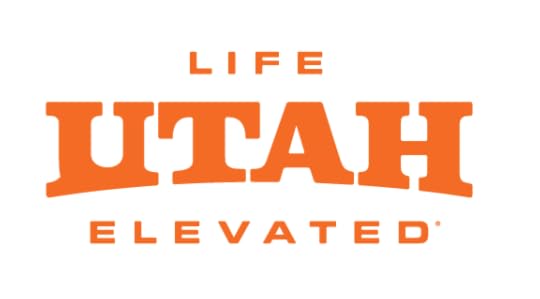 This post was proudly produced in partnership with Utah, home of The Mighty 5®.
This post was proudly produced in partnership with Utah, home of The Mighty 5®.

Signs your mom is Portuguese

Photo: Pedro Ribeiro Simões
Clique aqui para ler e comentar esse post na MatadorBrasil. Também venha curtir nossa página no Facebook.
1. You know something bad is about to happen you get called by your two first names.
Almost every Portuguese person has two first names. The second one is for the exclusive use of our mother when she is really angry at something we’ve done. So, if you hear someone call you by your two names, you can be sure that you are about to pay for something you have done.
2. You risk being caught by “Papão” if you go to bed later than you are supposed to.
This imaginary character is very popular among Portuguese mothers, who invoke him whenever we refuse to go to bed early. We are told that if a child is still awake when he visits, he will take her with him to a distant place, never to return.
3. A dish full of water and some drops of olive oil are the cure for your light malaise.
Our mothers call it “benzedura.” They say it treats “evil-eye,” something we can easily catch in the street when someone looks at us with bad thoughts. Whenever we get it, it’s imperative that this ritual is done to us. Otherwise, it might turn into a more serious disease.
4. You feel guilty when you throw bread in the garbage.
Bread is an important Christian symbol. It represents the body of Christ. Portugal is still a country with a strong christian tradition. Even if the family is not religious, mother always recommends we kiss the bread before we throw it away. It is a way to ask God forgiveness for mistreating his son’s body.

More like this How to piss of a Portuguese
5. You know 1,001 ways to cook codfish.
Dried codfish is a fundamental part of Portuguese gastronomy. It is normally served at special occasions like Christmas or birthday celebrations. Every mother has her own special ways of cooking it. She proudly improves her skills on every recipe she learns. Inevitably, we end up learning some good tricks to cook the “bacalhau.”
6. Sweet cornstarch is the magical cure for every ailment of the soul.
Were your school grades lower than you expected? Did you have a fight with your best friend? Your loved one disappointed you? The best cure is to sit at the table and wait for your mother to cook you a warm dish of cornstarch with lemon zest, cinnamon, and sugar and tell you that everything will be alright.
7. When you are away from home for a long period of time, you start craving bean and cabbage soup.
This soup is a regular presence in every mother’s menu. It is a comforting dish, unmatched by any other soup in the world.
8. You tremble when you see your mother opening her wallet to show pictures of you to her friends.
Every Portuguese mother carries photographs of her children in her wallet. Normally they are pictures of you as a baby either getting your diapers changed or learning how the use the potty. 

How to piss off a Bavarian

Photo: Joe Stump
Tell us we’re from Germany
There is a famous German movie telling the story of a group of Bavarians that win the Olympic bobsledding medal in the 1950s. Asked where they are from, they reply: “We are from Bavaria. That’s near Germany.” Exactly.
We are not connected in any way to these strange northern Germans, who drink beer in ridiculously small 0.3-liter glasses. Heck, we don’t even speak the same language! Bavarian is more closely related to Austrian dialects than to any of the northern-German ones. We might be bound to Germany thanks to incompetent politicians, but one day we will be free again!
Call anything that was brewed outside of Bavaria “beer”
We might not have invented beer, but we definitely perfected it. We implemented the Purity Law back in the 1400s, which means we were one of the first European nations to realize it’s not a smart idea to use the very same river for a toilet and as a water source for brewing. For more than 1,000 years we have been constantly working on improving our beer’s quality — we know what we are doing. So please don’t call anything brewed outside of Bavaria — or even worse, outside of Europe — beer. To us, it is just strangely colored water made by incompetent people.
Lump Bavaria in with Austria
Just because both have mountains, wear Tracht from time to time, and speak a hardly understandable form of German, Austria and Bavaria are far from being the same thing. Sure, we feel closer to our Austrian neighbors than to those from northern Germany, but there are big differences. They have an emperor; we have a king. They have Vienna; we have Munich. They have Arnold Schwarzenegger; we have good taste.
Try to speak the Bavarian dialect
So you’ve been learning German for some time now and can even have basic conversations. Good for you — we are well aware that German is a difficult bitch of a language. While we really appreciate everybody who puts time and effort into learning German, that doesn’t mean that you should try to speak Bavarian. We would rather listen to the sound of nails on a chalkboard for 24 hours straight than hear you violating our beloved dialect.
Assume we wear Tracht all the time and eat only sauerkraut
Sorry to disappoint, but we do not spend our days wearing dirndl (woman’s dress) and lederhosen (leather pants for men), eating sauerkraut, and dancing through meadows covered with flowers and cow poop. For the average metropolitan Bavarian, Oktoberfest is the only occasion to wear Tracht. But the other 364 days of the year, we wear — you won’t believe it — just the same normal stuff as everybody else in the Western world.
And, yes, from time to time we eat sauerkraut. But we also eat dumplings, pasta, pizza, French fries, and we even know what sushi is. Chances are high that the average US citizen eats more sauerkraut just on his hot dogs in the course of one year than any Bavarian consumes.
Ask if we have electricity and internet
We do have cities. We have culture. And we are part of modern civilization. There are people living in villages and farms in the countryside and some of them might look like they are extras from a 1960s Heimatfilm, but go inside and you might be surprised to find running water, electricity, and even wifi.
Eat Weißwurst after noon
Weißwurst (white sausage) served with sweet mustard, a pretzel, and a cold wheat beer is a traditional Bavarian dish that must be eaten before noon. In earlier days, when there were no refrigerators, one had to make sure to eat it before it turned bad. Now that we have fridges doesn’t change anything. Tradition is tradition.
Insult the king
Although no longer a monarchy, we are still very proud of our royal heritage. It left us architectural treasures like Nymphenburg Castle, the summer residence of the royal family in Munich, and Neuschwanstein Castle, the inspiration for Walt Disney’s Cinderella Castle. And, more importantly, the royal heritage left us enormous national pride and a unique national identity. Even today there is a large number of Bavarians who wish for the glorious old times to come back and want to reinstall the monarchy. But most of us would be more than happy if we could just gain independence from our annoying Prussian neighbors!
Make jokes about Petting
Yes, there is a village called Petting. No, it’s not funny any more. Get over it. Words can have different meanings in different languages. 

October 20, 2014
12 signs your husband is Mexican

Image by Lindsey Kone
1. You’re expected to have kids as soon as you get married.
From the day after you get married, you will be asked on a weekly basis by every single member of his family, “When are you having kids?”
2. Your husband’s family is enormous.
At your wedding, over 70% of the guests were from your husband’s family. This also means that your weekends are filled up with family reunions for baptisms, birthdays, weddings, and graduations.
3. You never get called by your name.
Mexicans are all about nicknames, especially with loved ones. Your husband never calls you by your name, but instead calls you amor, corazón, or vieja. This is also true with his family, who now call you sobrina, nuera, or prima. And his friends have undoubtedly come up with a nickname for you, too.
4. Your other half is not afraid of PDAs.
Mexicans are known for kissing in public and holding hands, and your husband still does this now you’re married.
5. You understand what it truly means to go to a Mexican party.
When you go drinking with your husband’s friends, the party doesn’t stop till at least 6 am. Then comes the hangover breakfast, and maybe even more drinking!

More like this: 12 signs your girlfriend is Mexican
6. You have discovered the joys of real Mexican food.
Your husband has introduced you to real Mexican food, not burritos and fajitas, but tacos, chalupas, molotes and much, much more!
7. You’ve learnt to speak like a real Mexican.
You not only speak Mexican Spanish but you have the slang down to a tee. You now say “¿Qué pedo?” for “What’s up?” and use words such as chingar, cabrón, and caga perfectly.
8. You’ve realized that Mexicans have a hard time saying “No.”
So you now use words such as ahorita, gracias, and sí to avoid it.
9. Your mother-in-law is the most important person in the family.
No doubt about it. To have his mother’s approval is the first step toward a more harmonious and peaceful marriage. Not only this, but the mother generally organizes the social schedule and has the real power in the family.
10. You’ve achieved the highest form of respect in Mexico: You love spicy food.
You never used to be such a fan of spicy food, but now you can’t live without it. Your tongue can now handle as much spiciness as Mexicans can, and that gets you a lot of respect.

More like this: 7 signs it's your birthday in Mexico
11. You’ve come to the conclusion that Mexicans are experts at being late.
So as to avoid falling victim to ‘Mexican time’, you have to make appointments at least 30 minutes earlier than the time you really want to meet up.
12. You know that in Mexico there’s nothing more important than family.
Family, then food, are the most important part of a Mexican’s life. Your social life is now based around it. Every Sunday is family day. You always have some sort of meal with your in-laws or a family reunion. It might feel intimidating at first, but there’s nothing more wonderful than the community feel of a big Mexican family. 

10 Kiwi phrases you need to know

Photo: Simon Oosterman
1. Rattle ya dags! | Hurry up!
This one’s a bit gross. The dags are the parts of fleece around a sheep’s bum that are usually caked in poo. Basically, they rattle when the sheep runs.
2. Just popping to the dairy | I’m going to the convenience store.
Kiwis get a lot of grief about this phrase — or any unwarranted use of the word “dairy” for that matter — from our Aussie neighbors. To us, a dairy is a corner store, or wherever you can pick up a loaf of bread, bottle of milk, ice cream cone, or drink.
3. I’m knackered. | I’m tired.
Example: “I’m completely knackered out from that rugby match.”
4. Wop-wops | Middle of nowhere
This can also be used when referring to the New Zealand countryside. The wop-wops are often teamed with the phrase tiki-tour, which refers to “taking the long way round,” or just getting totally and utterly lost.
Example: “We took a tiki-tour to the beach and ended up in the wop-wops.”

More like this: 15 dead giveaways you're from New Zealand
5. Get your A into G! | Rattle ya dags!
Another way to say “hurry up,” the full sentence is actually: “Get your arse into gear!”
6. Pakeha | Fair-skinned
In the 1800s, this Māori word was originally used to describe the fair-skinned new settlers. It’s still used to this day.
7. It was choice, bro! | It was good.
“Choice” is a versatile word in New Zealand, and pretty much means anything that’s positive — “ok,” “cool,” “I agree,” “I understand,” “It’s been good.” And every Kiwi knows that a bro isn’t necessarily a brother — though they could be. A bro is anyone from a good friend to a random stranger. Cuz is used in the same way.
8. Kia Ora | Be well.
This is an informal Māori greeting that a lot of Kiwis use everyday. It literally means “be healthy” and can be used to say hello, thank you, or goodbye.
9. Eh? | What?
Pronounced “Aye,” this one can get a little tricky. It can be phrased as a question, “That was a great movie eh?” But it can also be popped on the end of a sentence and serve no purpose at all — “I went to a great movie on the weekend eh.”
10. Yeah-nah | No, thank you.
Even though it reads like both a yes and a no, yeah-nah is basically just a polite no.
Example: “Yeah-nah, don’t want to go to the pub bro.” 

October 19, 2014
11 best Airbnbs in Buenos Aires
While already well known in the US, Airbnb’s been gaining popularity around the world. The service, allowing travelers to experience a home-away-from-home environment, has changed the landscape of accommodation options. From generous hosts to unique spaces, Airbnbs add to the excitement of a vacation. Sometimes they’re also just plain cheaper than hotels.
From an apartment suited for a solo traveler to an eight-bedroom home that could accommodate a soccer team, these are our favorite Airbnbs in Buenos Aires.
One
This villa in the residential town of Acassuso, about 13 miles from the city of Buenos Aires, has three bedrooms and four bathrooms, an organic vegetable garden for those looking to cook healthy cuisine, and a parrilla for grilling Argentina’s famous meats. With the pool and ping-pong table on the grounds, renters may be tempted to throw a party.
(View the listing)
Two
Found in the heart of Palermo, this three-bedroom house has no shortage of outdoor space—step outside and you’ll find a color-changing, heated swimming pool, a parrilla, a dining area, and an adjustable canopy (just press a button; it’s electric). And in the event that you’d rather stay inside, you’ll want to make use of the cinema area.
(View the listing)
Three
This Palermo Soho home is referred to as “La Casa.” Creative, we know—but it’s an impressive one. Renovated in 2010, the house has a minimum stay of five nights. The three-bedroom house has a BBQ area and a wrought-iron spiral staircase that brings visitors to the rooftop terrace. Located a short walk from Plaza Serrano, “La Casa” is close to all the action.
(View the listing)
Four
This three-bedroom penthouse sits on the 17th story of an apartment building. And it happens to take up the entire floor. We know you don’t want to walk up 17 flights of stairs—don’t worry, there’s a private elevator that deals with the issue rather effectively. The large windows all over the apartment, from living room to bedroom, allow for unrivaled views of the city. As for the staircase in the apartment, well, it leads to the private rooftop terrace.
(View the listing)
Five
From the art on the wall to the color schemes, this three-level duplex emplys a modern, pop-art theme—and it works. What are the three levels, you ask? The first level contains a living room, dining area, kitchen, and guest bathroom. Extra guests? The sofa bed handles that. Level two? A master bedroom and a sitting area with a leather armchair. The third level is the rooftop terrace.
(View the listing)
Six
“Casa Unica” in Palermo Soho is a three-bedroom house with an outdoor pool. The living room’s wall-sized windows provide a panoramic view of the garden and pool. And if guests prefer a bird’s eye view, a quick walk up to the rooftop terrace will remedy that. If you have a car or two for the duration of your stay, don’t worry—there’s room.
(View the listing)
Seven
This Palermo home is nicknamed “La Onda.” Though it’s in one of the city’s liveliest areas, guest reviews note that the apartment is surprisingly quiet. The two-floor apartment’s interior is decorated with modern furniture and Argentinian art. If you choose to have a night in but want to spend some time outside, the heated outdoor pool on the private rooftop terrace is your answer.
(View the listing)
Eight
Situated in Recoleta, this one-bedroom apartment is ideal for a couple or solo traveler. With a complimentary weekly maid service and small business center (including those hard-to-find corded phones), the apartment caters to longer-term travelers who’ll be working during their stay. If you want to give mate a taste, there’s a gourd ready for you to use.
Nine
If you’re traveling with a gang of 15 or more people, this eight-bedroom Villa Crespo home could accommodate your party. The house has so many beds you’ll lose count, art prints on the wall that’ll keep you from getting bored, and wifi to use when you’ve temporarily had enough of your 15 friends. Like many of the other Buenos Aires listings, this one also has a patio. If you find yourself having trouble deciding where to go for dinner or drinks, let your hosts give you a suggestion.
Ten
This loft is located on a quiet street in Palermo Hollywood. With rustic wooden furniture and a modern aesthetic, this apartment wouldn’t seem out of place on an interior designer’s Instagram page.
Eleven
With a small herb garden, sunny roof terrace, and parrilla, this apartment has an outdoor area that can easily compete with its well composed interior. Deciding where to sit when not sightseeing might be a little more difficult than in most hotel rooms. There are high ceilings, exposed brick walls, and windows nearly 10 feet tall. Originally a general store, the apartment was later a restaurant before its recent conversion into a home. Just look around the apartment—you’ll see its history in the almacen ceiling and the bodega’s original scales.
(View the listing) 

October 18, 2014
10 idioms only Italians understand

Image by Erin McGregor
1. In bocca al lupo / In culo alla balena | In the wolf’s mouth / In the whale’s ass
These two expressions for good luck are well-known throughout Italy, but clearly they don’t make any sense. Maybe they came into use because a simple “good luck” (buona fortuna) was too plain and boring.
2. Avere le braccine corte | To have short arms
In Italy, cheap people are said to have “short arms.” Just imagine a tyrannosaurus rex trying to reach into its pockets for its wallet. Impossible, even if it’s his turn to pay the round of drinks at the bar!
3. Non mi rompere i maroni | Don’t break my chestnuts!
Typically what you’d say to someone annoying.
4. Hai voluto la bicicletta? E adesso pedala! | You wanted the bike? Now you’ve got to ride it!
This is used when someone refuses to take responsibility for his or her own actions. It’s said with very little empathy and lots of sarcasm, so either you don’t like your friend so much or you already told him several times that he was making a mistake.
Example:
A: Oh man, I lost everything on Saturday night at the casino!
B: I told you not to gamble! Hai voluto la bicicletta? E adesso pedala! 
More like this: 10 extraordinarily useful Italian phrases
5. Braccia rubate all’agricoltura | Arms stolen from agricultural work
This comment tends to refer to someone doing something intellectual when they clearly don’t have a clue of what they’re doing. Basically, they’d be better off working in a farm.
6. Tirare il pacco | To throw the package
When you “throw the package,” it means you didn’t show up to a date or meeting with a friend.
Example:
A: Did you meet up with Luca yesterday?
B: No, he didn’t show up. Mi ha tirato il pacco.
7. Si chiama Pietro e torna indietro | Its name is Peter and it comes back
When someone wants to borrow something from you, you lend it by saying, “Its name is Peter and it comes back.” In English, this doesn’t make much sense, but it works in Italian because Pietro and indietro rhymes.
In English, this idiom would sound better if it said, “Its name is Jack and I want it back.” I still wouldn’t try it with my English friends though. The only response I’d get is a blank stare, but this phrase is so well-known in Italy that people often skip the second part.
Example:
A: Hey Marco, can you lend me your PlayStation for the weekend?
B: Of course, but si chiama Pietro…
8. Fare le corna a qualcuno | To have the horns put on you
This is an extremely popular saying in Italy. If your girlfriend “puts horns on you,” it means she’s cheating on you. If you want to piss off the guy in the car in front of you, because he didn’t respect your right of way, stick your hand out of the car window and show him the ‘rocker’ hand sign. In Italy, unless you’re at an AC/DC concert, this is very offensive as you’re basically saying his wife cheated on him and he has horns on his head. You can use it to offend someone, or just use it casually in conversations.
Example:
A: How are Maria and her boyfriend?
B: Not good man, gli ha fatto le corna!
9. Non avere peli sulla lingua | Without hair on his tongue
When you ask a friend of yours to speak his mind and to be brutally honest with you, even if you’re not going to like his opinion, you ask him to say it “without hair on his tongue.”
Example:
A: Tell me Marco, what do you think about this article?
B: I’m going to tell you senza peli sulla lingua. It’s crap!
10. Vai a farti benedire / Vai a quel paese | Go get blessed / Go to that town
Italians have many different ways of telling someone to get lost. Obviously we have an equivalent of “F@*k off,” which I’m not going to explain as I’m a polite fellow writing a polite article, but two well-known ways to tell someone to “piss off” are vai a farti benedire, “go get blessed,” and vai a quel paese, “go to that town.” 

17 portraits of Alaska's bears
EVERYONE WHO VISITS ALASKA hopes to see a bear. They might tell you they’re scared of them, but deep down they really want to see one. It’s a rush, I can’t blame them. Nothing on Earth embodies the wild like a bear.
I’ve spent over a decade finding places to watch these amazing creatures and will never tire of it. I’ve seen big bears, little bears, handsome bears, and ugly bears and can tell you definitively that every bear you see is a distinct individual with its own biases and ways of surviving in an often harsh environment.
Most bear sightings take the form of a bear’s butt as it runs off down the trail or crashes into the alders to get away from you. Even that fleeting glimpse is enough to make someone’s time in Alaska “the trip of a lifetime.” For those lucky enough to spend an hour, a day, a week, a lifetime watching bears, the experience is transformative. 
All photos by author

1
Brown bear
Brown bears and grizzly bears are the same species. The distinction is geographic. Grizzly bears live in the interior of Alaska and are smaller in size than their coastal relatives. More productive habitat and access to salmon allows coastal brown bears to get much larger.

2
Polar bear family
Polar bears are the masters of the Arctic. They prefer to spend their time hunting seals out on the ice, but the ice cap isn't what it once was. Many of these bears are now forced to spend more time on land waiting for the seasonal return of the ice.

3
Black bear
Black bears are the most numerous type of bear in Alaska. While most of the black bears I see are actually black in color, in other parts of Alaska and North America they can range from a blueish black, to cinnamon, even white (Kermode bears in BC).
Intermission
Arctic safari: 13 stark images from the land of polar bears
by William Drumm
2
11 stunning images of Arctic wildlife
by Espen Lie Dahl
1
Free-diving with the whale sharks of Papua [pics]
by Diana Himmelspach

4
Brown bear with yearling
Not all bear mothers are created equal. In any population there are going to be certain female bears that are just better at raising cubs. It's not a hard and fast rule, but brown bear cubs will generally spend two and a half years with mom learning how to be a bear.

5
Bears at McNeil Falls
In certain locations, seasonal congregations of brown bears are a sight to behold. The most notable are McNeil Falls (pictured, McNeil River State Game Sanctuary) and Brooks Falls (Katmai National Park).

6
Bear fight
Bears don't fight as much as one might imagine. They are powerful animals and injury can mean death. Most conflicts are decided through posturing and acting tough. These guys made a lot of noise but never actually touched each other.

7
All-star brown bear
This is one of the most amazing bears I have ever watched. She was highly effective at fishing, seemed to have good parenting skills, and was incredibly photogenic.

8
Polar bear family
A polar bear family near Kaktovik, AK tries to grab a nap. The cubs weren't having it though, and soon they were wrestling and bouncing around under the watchful eye of their mother.

9
Bear in the reeds
It has always amazed me how fast bears can disappear. You would think a several-hundred-pound animal would be hard to hide. The fall colors near the mouth of the Brooks River make excellent bear camo.
Intermission
1
On the trail of gorillas in Odzala National Park, Congo
by Sophie Smith
1
Hunting the Northern Lights in Fairbanks, Alaska
by Scott Sporleder
3
Memories of summer in Alaska
by Hal Amen

10
Bear fishing
In order to catch migrating chum salmon, this bear sits in the current facing downstream. His large body creates an eddy, and when fish swim in all he has to do is dip his head and grab them.

11
Polar bear
On the barrier islands around Kaktovik, AK in certain times of the year, there are bears as far as you can see. At first you look over the horizon and see snow piles everywhere. Those aren't snow piles...they're polar bears.

12
Sharing the streams
Anytime you're on a salmon stream in Alaska you could encounter a bear, so it's important to make noise, travel with partners, and never run from a bear. Don't freak out. Remember that just because an animal can hurt you doesn't mean it wants to. It will probably be the highlight of your trip.

13
Brooks yearling
A sneaky little cub. Mom and siblings had already gone downstream to look for salmon, but this little female stopped to check us out before scurrying to catch up with the others.

14
Brooks River salmon
It comes as a surprise to many that brown bears aren't bloodthirsty killers waiting behind every bush to devour you. This bear was fishing for sockeye salmon on the Brooks River in Katmai National Park and just went about her business catching fish as if we weren't even there.

15
Piles of polar bears
At the end of the summer polar bears will congregate along the coast, awaiting the return of the ice so they can head out to hunt seals.

16
A bear's skill set
The physical prowess of bears is hard for us mere humans to comprehend. The best way to see how you compare is to try running upstream through knee-deep, 34-degree water, and then catch a salmon in your teeth. Good luck.

17
Bear at sunrise
A beautiful sunrise over Naknek Lake in Katmai National Park. Katmai is pretty much ground zero for bear viewing, but there are any number of great places to watch bears in Alaska. When you're planning your next bear viewing trip, google the following: Anan Creek, Pack Creek, Wolverine Creek, Silver Salmon Creek, Lake Clark National Park, Denali National Park, Kodiak National Wildlife Refuge, Kaktovik, McNeil River State Game Sanctuary...the list goes on an on.

October 17, 2014
11 Asian-American rites of passage

Photo: kaybee07
1. You visit your parents’ home country for the first time and realize how American you really are.
If you are American born, the first time you visit the country of your parents’ origin can be a shocker. It’s nothing at all like the homeland that your parents talked about from their childhood. The food is unique, the people dress differently, and you realize for the first time that you speak your parents’ language with an American accent. When a local actually calls you a foreigner, you realize that while in America, you may be perceived as Asian, but in Asia, you are perceived as American.
2. You discover the pros and cons of being known as a “model minority.”
Asian-Americans are typically known for being hard working, law-abiding citizens who value education and traditional family values. As you grow older, you learn that this perception has its advantages and disadvantages. Teachers, employers and even total strangers often give you the benefit of the doubt, assuming you are a well-behaved Asian boy or girl. But on the other hand, this image often leads people to assume that Asian-Americans don’t suffer from discrimination, familial dysfunction, physical abuse, mental illnesses or crime. You come to realize that the whole idea of being a model minority is a myth that is unhealthy to perpetuate.
3. You learn to speak up or get left behind.
In general, Asian cultures stress group harmony over individualism. You grow up learning to be quiet, practice modesty, listen to authority figures, and not rock the boat. However, as you enter college and the work world, you realize that the rest of society doesn’t necessarily value these traits. Thus, you learn the hard way that the promotion, raise, or high marks in your MBA class depend on you speaking up and drawing attention to yourself, however uncomfortable it makes you feel.

More like this 17 signs you were raised in a Chinese-American family
4. If you’re a woman, you learn how to recognize when a man has Yellow Fever.
Asian women are sometimes perceived by non-Asian men as exotic, and either subservient like a geisha or vampy like a dragon lady. This doesn’t mean that we don’t have wonderful, successful inter-racial relationships. But Asian-American women are particularly wary of those men who practice kung-fu, take Japanese language lessons, or live in Hong Kong for the sole purpose of dating Asian women. We call it Yellow Fever. It’s never a turn on, no matter how good looking the guy might be.
5. If you’re a man, you learn to overcome the stereotype that you’re not as masculine as other American men.
Asian-American men have been portrayed as sexless or feminized figures in Western media. While it’s common to see white men pair up with “exotic” Asian women on TV and in the movies, it’s rare to see an Asian-American in a leading role, and even rarer to see him romantically involved with a white or African-American woman. Thankfully, with more hunky yet intelligent Asian actors like John Cho and Daniel Dae Kim defying these stereotypes, there is much more for women of all ethnicities to swoon for.
6. You get used to hearing “konnichiwa” when you travel abroad, even if you’re not Japanese.
This happens to me almost everywhere I go in Europe or Latin America. Someone — either a shop keeper or a group of boys hanging out on the street — yells konnichiwa (hello), even though I’m not Japanese. People don’t necessarily mean anything negative — they are often just trying to communicate across cultures. But hearing this again and again makes you realize that to a lot of the world, we’re all just one big group of undifferentiated Asians. While we can tell the difference between Chinese, Japanese, Koreans and Vietnamese among ourselves, most non-Asians have no clue. When I feel frustrated, I just remind myself that I often can’t immediately tell the difference between a German and a Swiss, or a Kenyan and a Nigerian. So I usually just smile and say konnichiwa right back.
7. You learn how to deal with the question, “but where are you REALLY from?” with grace and patience.
Every now and then, you come across someone who can’t understand that while you are of Chinese or Vietnamese ancestry, you are in fact American born, and San Francisco/Boston/Houston is your real hometown. While occasionally this reflects a kind of racist outlook, more often than not, this question comes from people who are genuinely curious and may have grown up in a homogeneous environment. I try to use these opportunities to gently remind people that, unless they are Native American, all of our ancestors are ultimately from somewhere else.
8. You realize how important it is to be connected to and support the Latino and black communities around you.
Asian-Americans are often portrayed — fairly or not — as the quiet minority. We work hard and keep our heads down. This is, in large part, due to the anxieties our immigrant parents or grandparents had around being in a new country and fitting in. But at some point, we realize that discrimination isn’t something we are immune to. When somebody gets racially profiled or harassed because of their ethnic background, it is our problem too. And the civil rights we enjoy today are because of the sacrifice and vision of people like Martin Luther King, Jr, and the brave people who fought for dignity and equality for all. We owe it to them to be engaged.
9. You realize you really do have a “rice stomach.”
At some point in your life, you find yourself in a situation where rice is not the primary starch in meals. Sure, you will feast on wonderful pastas in Italy or tortillas in Mexico or bread in Germany. But at some point in your world travels, you will really, really crave a simple bowl of hot, steaming white rice. As your mother once told you, we Asians have “rice stomachs.”
10. You consider getting your eyelids done to look more Caucasian. Then you realize how ridiculous it is to try and conform to one standard of beauty.
If you are an Asian-American who has gotten your eyelids surgically changed to look more Caucasian, peace and love to you. But for the rest of us – yes, it is common to grow up, surrounded by images of tall, thin, blond haired, blue eyed models, and to wish we could conform more to these standards. But at some point, we realize that instead of changing ourselves to look more like that standard, we can work towards a more ethnically diverse palette of what is considered attractive in the U.S. Hey, even JLo initially had to struggle to get her Latina booty accepted in a world of rail thin celebrities. We can and should celebrate our almond shaped eyes.
11. You come to the conclusion that George Takei is a national treasure.
You may have been too young or not even born yet to have appreciated the original Star Trek. But whether or not you were a Sulu fan, you follow George Takei on Facebook and Twitter and can’t think of any other celebrity you’d rather have over for a barbecue. He was the first and still the best Asian-American male stud, who has talked candidly about his youth in a Japanese internment camp and is now a spokesperson for LGBT rights. He is The One. 

Matador Network's Blog
- Matador Network's profile
- 6 followers




